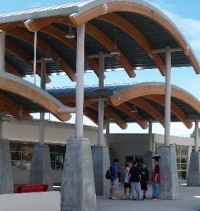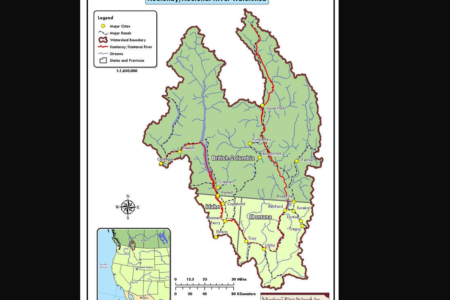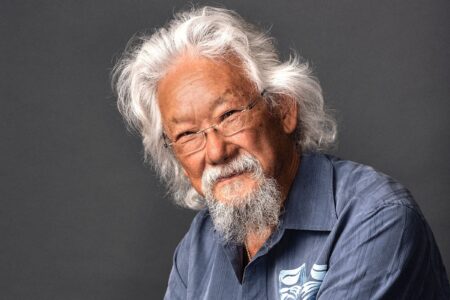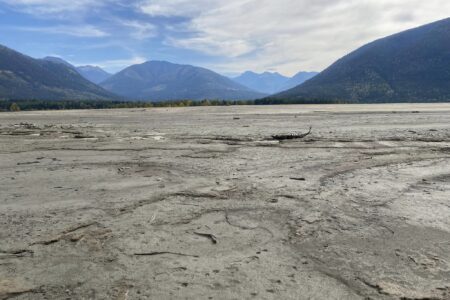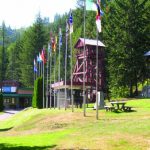Academies - The Future of Schooling in Rossland?
It has been said many times and in many ways that tough situations breed new opportunities and innovation. In a time of shrinking enrolment in our schools and coming on the heels of a number of school closures in the area in recent years, Rossland has a number of groups working towards saving our schools in a number of different fashions.
Having just completed its fourth year in operation, Red Mountain Academies might just be one of a number of innovative solutions to keep our schools open. The benefit to the academies program, as opposed to some of the other solutions bandied about, is that it is already operating successfully and on the verge of a major expansion in the near future.
The idea of using existing underutilized schools as home bases for specialized academy programs is not a new one by any stretch. Shrinking enrolments across the province and country, however, have recently brought it back into the limelight as an option to grow district enrolment. With a current funding structure that funds schools on a per student basis, any program that puts more bums in classroom seats should be a major benefit to schools and their districts.
Dianne Nelson of Sentinel Secondary School in West Vancouver spearheaded an academies program that has been wildly successful for parents, students and the school. Formerly the owner of the Vancouver Griffins WNHL team, a business leader and a teacher, Nelson acted on suggestions from parents that she find a way to lend her skills to developing youth sport.
“They had all these rinks sitting empty and Sentinel has a very unique timetable which allows us to schedule coursed in the morning and we have a static block in the afternoon so you could schedule kids from 1:00 on to teach them an applied skill, or give them the opportunity to replace that with a sport focus,” explained Nelson. “I basically took that idea and I had a passion for hockey so I started to see if A) I could get their timetable coordinated and B) if I could find a facility. I ran it by a few people and they thought it was fabulous.”
Seven years ago w hen the hockey academy was launched at Sentinel High School, they were feeling the effects of declining enrolment at their school although for much different reasons that in Rossland. With a number of private schools in the high income community, public schools like Sentinel were constantly competing to attract students. After the rule that you had to attend a school within your district was dropped, the superintendent tasked the school with coming up with creative ways to attract students. Nelson thought about her favourite memories of her own school days and decided that bringing a large sport element into the mix would get kids excited about coming to school.
Utilizing the available facilities of a near-empty country club within walking distance of the school (complete with NHL-sized arena) Nelson set about posting ads and talking to parents in the region about starting up a hockey academy. Community support was huge for the idea and she quickly launched the academy with 16 students.
Over the course of its first seven years, the academy program has expanded to over 150 students in hockey, soccer or tennis. In addition to focussing on sports and developing well-rounded athletes, the program also has a heavy focus on academics and has found kids more willing and excited about coming to school in the morning knowing they’d be practising hockey or soccer or tennis in the afternoons. The program has already sent one girl on a full scholarship to the University of Minnesota (for hockey) as well as had numerous boys drafted in the midget hockey draft.
The key to making the academy program work at Sentinel was having Nelson championing the project. It took one person dedicated to the program who could utilize her business skills along with education skills and passion for hockey to bring the program into success. Nelson received no outside funding to launch the program and cost nothing to the school or district while giving back to the school through increased attendance and funding that goes along with that.
“If you can break even, that’s beneficial because you’ve got happy kids and happy parents and they love school and they love coming and they get involved more and they do better in their studies. If nothing else it’s a very good PR program for the school itself that it’s a fun place to be,” explained Nelson.
It took negotiating rates with professional coaches, facilities (She got use of the nearby country club rink at no charge) and growing the program in increments that meet the student teacher ratio to keep to program in the black ink.
Finding that community champion to lead the project in Nelson’s eyes is the biggest hurdle to building and growing a successful academy program.
“Number one, I would find a person who has a passion to do it and give them a chance to pick a sport that they are interested in and work with the principal at the school to see if they can start small and get it going. Don’t try and do too much too soon and just bite off enough you can handle it and do a real good job with those kids you signed up and it will take off.”
In Rossland that person is Bernie Hoffman, principal of the Red Mountain Academies along with his pros in each discipline, Alpine racing, free-skiing, dance, and–new this season–snowboarding.
The Red Mountain Academies’ genesis stemmed from needs expressed by the parents of ski racers in town and the desire for their ski racing children to receive a better education that fit with their athletic demands.
“Once it got to a certain level for ski racing, the amount of time they are missing from traditional classes, a lot of them weren’t competing there classes on time or completing with a lot of gaps and usually leaving students with the pressure of choosing either ski racing or education cause it was hard to manage both. So Red Mountain Racers approached the school district and the high school at that time and wondered if they could cooperate to create some type of ski academy and that’s basically how it got started,” explained Hoffman.
Originally launched as four month pilot program with 15 students (all but one of which were from the local area) the program was an instant hit with both students and parents. Looking ahead at the declining enrolment numbers, folks involved in the school and academy started thinking of different goals that could be achieved through the academy.
“That wasn’t the original intent (increasing enrolment) of the program but we then started to look at it and said let’s make it available and see what kind of interest we get. From the first year we had students from outside of the area,” noted Hoffman “We’ve got the potential here to be really on the leading edge of academies. A big part of it is believing in these programs and believing in a 5 year plan and going out and achieving it.”
Steady and manageable growth has been the mantra of the academy through its first four years. Now having expanded to include free skiing, dance and snowboarding, the 10 month program currently serves 26 students, all based out of RSS.
Clearly a success already in its toddler years, the academy has big plans and sees the current school attendance crisis facing Rossland as an opportunity to take the academy to the next level. Rossland Secondary has the capacity for adding several hundred students and the academy program costs nothing to the school board. It would seem a program that breaks even, costs the school board nothing, fills up empty space at RSS, fits with the passions of the city, and brings new dollars to the school through enrolment from children outside of the area is a natural cure for what ails Rossland’s schools.
The effort to find new ways to maintain small schools may just provide the impetus to move on expanding the academies and in turn save our schools.
“We’re at the crucial point right now with the stars aligning once again and we can look into a fairly significant expansion within the next there years. We have proven that we have a program that students and parents believe in and come back to–our return rate last year was significant. It’s a matter of in the next year coming up with a clear organizational structure so we can then outline a marketing plan to attract the students. I’m sure we can attract a significant number of athletes to this area and the program.”
Finding the business and marketing expertise in the community to help move the academy forward is the next step to achieving the potential of the program. The issue as described by Hoffman is that the academy is currently run by educators and coaches and needs some assistance in putting together a marketing and recruiting plan to attract the students to the program.
“We’ve had interest from students in every province in Canada, the US, UK, Australia and Czechoslovakia so there is lots of interest out there. We feel like we’ve got something that could potentially be quite large once we’re ready to go to that next step and I think we’re close to that,” explained Hoffman.
Having Red Mountain practically in the school’s backyard is a major asset to the program and Hoffman noted that Red Mountain Resort has been excellent to work with and instrumental in helping them achieve a successful program. Looking down the road a coordinated project currently in the planning phase between Red Mountain Resort, the Red Mountain Racers and Red Mountain Academy is to develop a high level training facility at the base of the mountain. While still somewhat in the dream stages, this would include a gym, workout, training facilities and all that is required to develop high level athletes. Such a facility would be a perfect complement to the existing racing and academy program and would undoubtedly raise the profile of the academy and help attract more international students to the program. Another key part of the long term plan in cooperation with those same three groups would be getting a snowmaking system installed on Red to ensure reliable early and late season snow for training.
“The high performance centre and artificial snowmaking would be critical to the academies really going big,” noted Hoffman.
In the immediate future the academies are working to stay viable and grow modestly while they complete marketing and strategic planning with RSS to map out the future of a greatly expanded academy that would attract students from around the world to live, train and go to school in Rossland.
“The reality in the short term is we’re working on just keeping it viable,” added Mark Impey of the free skiing program. “We need a group of kids next year to keep the program running. We have to keep it going. It does look like a go now, but it still needs to get some momentum going to ensure there is a market for it.”
For now Hoffman and friends will continue working with VSS, the School District, RSS and Red Mountain to figure out the best way to move forward together and get heavier into marketing the program and recruiting students. While likely not the only solution to saving RSS, the Red Mountain Academy is already on the ground and running and with some assistance in marketing will be ready to take the next step in the very near future.
It has also been said many times many ways that it’s easier to keep an object in motion than to start a new object moving. The combination of the current “school crisis”, passionate educators, coaches and parents and a high ranked high school with a ski hill in the back yard appear to be the perfect recipe for success
“I would hope that five years down the road we’re well known for our academy and I would hope it’s a program that athletes strive towards and strive to get in. High level athletes being able to train in their desired sport in a highly academic environment. That’s what it’s all about,” concluded Impey.


